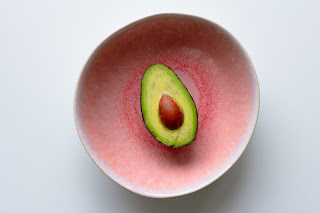What is fat and why do we need it? The understanding nutrients series
We’re back with another edition of the understanding
nutrients series! The aim of this series is to give you a better understanding of the
different nutrients in your food.
Following on from my post about low fat diets aren’t the
best diet to follow. I thought I’d
go into more detail about fat as a nutrient and its functions in the body.
What is a macronutrient?
Fat is one of the three macronutrients. A macronutrient is a
nutrient we need in large quantities in the diet. They provide energy (calories)
and are essential for bodily functions. The other macronutrients are
carbohydrates, and protein.
Role of fat:
Fat has many roles, so I’ll touch on some of the main ones.
Vitamin absorption: the fat soluble vitamins A, D, E and K
need to be eaten with fat to be absorbed by the body. Without dietary fat,
you’re likely to be deficient in these nutrients.
Source of essential fatty acids: dietary fat is the only
source of essential fatty acids that our bodies can’t produce themselves. These
fatty acids are needed for important functions like controlling blood pressure
and supporting the immune system.
Warmth: fat acts as a layer of insulation, keeping your body
warm. It’s also triggered by colder temperatures to release energy in the form
of heat. A part of its role as
insulation is to also protect the internal organs by acting like a layer of
padding.
Energy storage: fat is a source of energy for the body. Excess
energy is stored in the body’s fat cells and can be released when energy is
needed.
Cell structure: fat is crucial for every cell in your body.
It forms the lining of the cell and controls what comes in and out of the cell.
Fat forming the membrane of each cell allows it to be less rigid.
Reproduction and hormones: fat is essential for
reproduction. Females need around 22-25% body fat in order to be fertile. This
is because fat plays a role in the production of hormones, including the
reproductive hormones.
Types of fat:
You may have heard of saturated fat, unsaturated fat and
trans fats. These are the three types of fat in our diets. To avoid a chemistry
lesson, I’ll try and keep things simple.
Fats and fatty acids are made of carbon, hydrogen, and
oxygen atoms. How the atoms are bonded to each
other determines the type of fat it is.
Unsaturated fat:
These fats have a double bond within their structure. This means there are carbon atoms connected to each other with 2 bonds instead of 1 like this C=C. They have a cis double bond. Cis refers to the position of the atoms around the double bond.
Unsaturated fats are broken down more into monounsaturated
fats and polyunsaturated fats. Monounsaturated means there is 1 double bond, while poly
means there are multiple double bonds in the structure.
Saturated fat:
This fat has all the carbons connected with single
bonds like this C-C and no double bonds. This means there are more hydrogen atoms within the structure as the
carbon can bond with more hydrogens. There are not different types of saturated fat, unlike unsaturated.
Saturated fat is found in foods like meat, cheese, butter,
coconut oil, and baked goods.
Trans fat:
These are unsaturated fats with trans double
bonds rather than cis bonds. Again, trans refers to the position of atoms
around the double bond.
Trans fat is not very good for your health. It increases the
risk of heart disease, and stroke. This is because it increases the level of
the LDL or ‘bad’ cholesterol which can build up in your blood vessel walls and
cause blockages.
Trans fats are found in foods like margarine, fried foods,
and biscuits. However, most people in the UK don’t eat a lot of trans fats as
food manufacturers have removed them from products.
How much fat should you be having?
The recommended amount of total fat is no more than 70g a
day.
Men should have no more than 30g of saturated fat a day.
Women should have no more than 20g of saturated fat a day.
We should also have no more than 5g of trans fat a day.
Foods that contain fat:
- 200ml of semi-skimmed milk has 3.6g of total fat and 2.2g of saturated fat.
- 30g of cheese has 10.5g of fat and 6.5g of saturated fat.
- 10g of butter has 8.2g of fat and 5.2g of saturated fat.
- A small avocado has 15g of total fat. 12g are unsaturated fats.
- A small handful (25g) of peanuts has 12.9g of total fat, 10g are unsaturated fats.
- A tablespoon of sunflower oil has 15g of fat. 11g are unsaturated fats.
What happens if you don’t get enough?
A lack of fat in your diet can lead to dry rashes on skin,
hair loss, and a weaker immune system.
This is caused by a deficiency of essential fatty acids;
these are the fatty acids we can’t make ourselves and need to get from our diet.
A diet low in fat can also lead to vitamin deficiencies as
we need fat to absorb vitamins A, D, E, and K.
Hopefully this post has given you more information about fat and why it's such an important nutrient. It's often demonised by diet culture but it plays many key roles in the body.
Key points:
- Fat is a macronutrient, a nutrient our bodies need in large amounts for energy and to carry out bodily functions.
- Fat has many roles in the body: absorption of fat soluble vitamins, energy storage, warmth, a source of essential fatty acids, cell structure, hormone production, and reproductive health.
- There are 3 types of fat: saturated, unsaturated and trans fats. They all have a different chemical structure. We should aim to have more unsaturated fats.
- We should be having no more than 70g of fat a day. Foods like nuts, dairy, oils and spreads, and avocado contain fat.
- A lack of fat in the diet can lead to dry rashes, vitamin deficiencies, and a weaker immune system.
I hope you enjoyed this post! I’d love to hear your thoughts
in the comments below.
Bye for now! 👋
References:
Role of fat: https://www.ncbi.nlm.nih.gov/books/NBK218749/
and https://www.ncbi.nlm.nih.gov/pmc/articles/PMC4190204/ and https://www.eufic.org/en/whats-in-food/article/facts-on-fats-dietary-fats-and-health
and https://pubmed.ncbi.nlm.nih.gov/25390014/
and https://pubmed.ncbi.nlm.nih.gov/2282736/
Types of fat: https://www.ncbi.nlm.nih.gov/pmc/articles/PMC2921725/
and https://www.nhs.uk/live-well/eat-well/different-fats-nutrition/
How much fat: https://www.nhs.uk/live-well/eat-well/different-fats-nutrition/
and https://assets.publishing.service.gov.uk/government/uploads/system/uploads/attachment_data/file/743790/Dietary_Reference_Values_-_A_Guide__1991_.pdf
Foods with fat: https://www.ncbi.nlm.nih.gov/pmc/articles/PMC4711439/
and https://www.ncbi.nlm.nih.gov/pmc/articles/PMC3664913/
and www.tesco.com and https://www.ncbi.nlm.nih.gov/pmc/articles/PMC5976617/
Deficiency: https://lpi.oregonstate.edu/mic/other-nutrients/essential-fatty-acids




.jpg)

Comments
Post a Comment